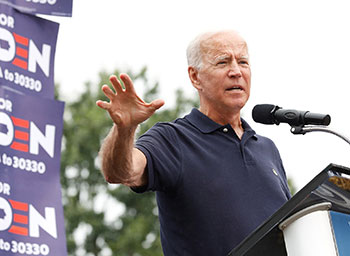Ordnance Survey employment records
Published in Features, Issue 6 (November/December 2019), Volume 27By Fiona Fitzsimons

Above: Senator Joe Biden—a descendant of Edward Blewitt of Ballina, who, along with his brother James, worked as a civilian assistant on the Ordnance Survey in the 1830s.
Evidence in family history consists of any source—a document, photo or artefact—with a name (or names), date, place-name or story attached to it. Even the dullest administrative documents can be turned to a genealogical purpose if they contain this base evidence.
In 1824 the Ordnance Survey (OS) opened for business in Ireland. It was to complete the first large-scale survey of an entire country, at the unprecedented scale of six inches to one statute mile. Over the next few years the OS began to engage teams of men to carry out the cartographical survey. Between 1824 and 1827, commissioned officers of the Royal Engineers and Royal Artillery were recruited to lead the endeavour.
Sappers and miners were recruited from the rank and file of these same regiments. They were the combat engineers trained to build field fortifications and siege works and to carry out demolition. The officers and enlisted men were trained in mathematics and surveying in the Royal Engineers’ Establishment (later the Royal School of Military Engineering) in Chatham.
The survey’s technical requirements were complex, and in 1826 Lt. Thomas Drummond became lead mathematician. The OS invited external supervisors to follow its progress, including astronomer John Herschel, Charles Babbage, inventor of the mechanical computer, and mathematician William Hamilton.
The OS military personnel were supported by civilian recruits. The most highly skilled were the ‘civilian assistants’, the trained draftsmen and surveyors. They were supported by the ‘country labourers’ responsible for the simplest tasks—the ‘meres-men’ who guided the OS officers along the boundaries, and the ‘chain-men’ who took measurements. By the late 1830s, the survey employed over 500 civilian assistants, who outnumbered sappers 4:1. The Ordnance Survey became a practical training ground where military and civilian employees could hone their technical and engineering skills.
The employment records of the cartographical survey provide detailed information about the people who worked there. In the 1830s we find brothers James and Edward Blewitt of Ballina, employed as civil assistants on the Ordnance Survey. In June 1838 James Blewitt reported an error in the logarithms to his supervisor, Captain Tucker, who referred it for further investigation. The error was checked and verified, and a new value calculated to correct the logarithm.
Blewitt’s finding confounded expectations, then and now. He was from a labouring background, and there is no evidence that he received any education beyond what was available in the local hedge school. Somewhere along the line, however, Blewitt acquired a knowledge of higher mathematics, so that he could critically assess what was taught in the Royal Engineering school in Chatham and find errors that had eluded Hamilton and Babbage.
After 1846, as the Ordnance Survey in Ireland wound down, the civilian assistants had the skills and experience to find other employment at home or overseas. In 1851 Edward Blewitt settled in Scranton, Pennsylvania, in the United States. Among his descendants is Senator Joe Biden.
Administrative records of the Irish Ordnance Survey, including letter registers, progress reports and lists of civilian assistants’ names by district/year, are held in the National Archives of Ireland, Bishop Street, Dublin.
Fiona Fitzsimons is a director of Eneclann, a Trinity campus company, and of findmypast Ireland.
















